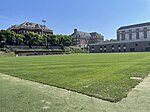Woodland Cemetery and Arboretum (200 acres), located at 118 Woodland Avenue, Dayton, Ohio, is one of the oldest garden cemeteries in the United States.
Woodland was incorporated in 1842 by John Whitten Van Cleve, the first male child born in Dayton. He was the son of Benjamin Van Cleve and Mary Whitten Van Cleve. The cemetery began with 40 acres (160,000 m2) southeast of Dayton and has been enlarged to its present size of 200 acres (0.81 km2). Over 3,000 trees and 165 specimens of native Midwestern trees and woody plants grace the rolling hills. Many of the trees are more than a century old and 9 have been designated "Ohio Champions." The highest point in Dayton is within the cemetery, and during the Great Dayton Flood of 1913, it became a place of refuge.
The Romanesque gateway, chapel and office, completed in 1889, are on the National Register of Historic Places. The buildings were constructed of the stone from the original cemetery wall. The chapel has one of the finest original Tiffany windows in the country. A mausoleum, with a rock and bronze exterior, features twenty-two varieties of imported marble and twelve large stained glass windows inspired by famous literary works. It was added in 1970. The oldest original 105-acre section of the cemetery, known as "Victorian," received a second designation as a historic district on the National Register of Historic Places in 2011.
A receiving vault large enough to contain 12 crypts was built in 1847 by Joseph Wuichert, who was said to be Dayton's premier stonemason. Throughout the 19th century it was used for temporary storage when burials were delayed due to bad weather or for other reasons (for example, refer to the article below on Levi and Matilda Stanley). Located near the main entrance to the cemetery and across from the mausoleum, it is constructed of giant limestone slabs and was designed as a replica of the Egyptian-style temple of Thebes and Karnak. It was unused for nearly 100 years but the exterior was restored in 2008 to its original condition.






